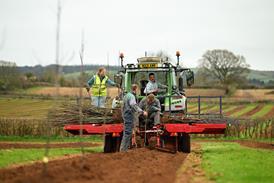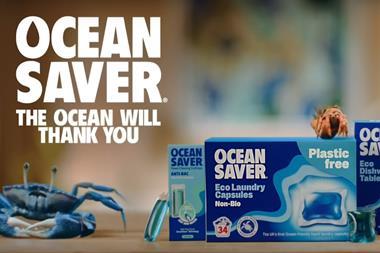The latest figures from Wrap suggest households are doing far better than the supply chain at cutting waste, says Guy Montague-Jones
The old adage “waste not, want not” has added significance in the age of austerity. Cutting the nation’s annual UK food waste bill from £17bn today to zero would go a long way towards paying for the £83bn of savings the government plans to make over the next four years.
The good news this week is that the size of the food waste mountain is coming down.
The bad news for the grocery supply chain is that it is struggling to reduce its waste to the same extent as households.
Homes in the UK threw out 3% less food in 2010 compared with the previous year, according to the latest figures from government agency Wrap. It means the Courtauld Commitment - the agreement signed by the grocery industry - is well on the way to achieving its target of cutting household waste by 4% over the three years to 2013.
However, progress on reducing waste in the grocery supply chain has been much slower. Wrap’s new figures show food retailers and suppliers only managed to cut their own waste by 0.6%, leaving much to do if they are to achieve the Courtauld target of cutting supply chain waste by 5% by 2013.
But could the substantial drop in household waste just be a temporary blip caused by the weak economy? And is the industry able to turn around its performance on supply chain waste in time to meet the 2013 target?
Wrap is certainly supportive. The latest dip in household waste is not just a consequence of cash-strapped consumers taking better care of what they buy. By introducing smaller portions, smaller pack sizes and better packaging, it says the industry is largely responsible for the consumer gains.
“The economy may be a factor but household waste began to drop before the recession,” says says Richard Swannell, Wrap director of design and waste prevention. “The industry has driven that through smaller portion sizes, meal deals and innovations like resealable packs - Heinz’s baked beans in a jar is a good example.”
Academics support his view. “The economy affects where people shop and what they buy but has little impact on waste,” says David Evans, a research fellow at Manchester University’s Sustainable Consumption Institute. “People waste food largely because they do not have control over the quantities they purchase.”
However, Evans warns that industry faces a conflict between the waste agenda and the healthy eating goal of promoting a varied diet packed with fresh fruit and veg.
“People face social pressures to cook and eat in certain ways - with fresh ingredients, from scratch and with variety day-to-day. These pressures cause people to buy food because they ought to, which they then find they either do not have the time or the inclination to cook and end up wasting,” he explains.
And that Christmas waste… Never is this more apparent than at Christmas. Asda published results of a survey last week suggesting almost one in five of those who attempt to cook a Christmas meal end up making a mistake and throwing it in the bin. The supermarket refrained from drawing any conclusions from the research - it could hardly be seen to be encouraging consumers to abandon their Christmas cooking plans and opt for an Asda ready meal instead.
But with health and waste both climbing up the public policy agenda, the 3% drop in household waste suggests any friction between the two has yet to slow down progress on the waste side.
More worrying for the industry is the slow progress on cutting supply chain waste. To reach the 5% Courtauld waste target over the three years to 2013, industry will have to go up a gear or two.
“It’s clear that more work needs to be done,” admits Lord Taylor, Defra minister for environment.
Wrap expects industry to rise to the challenge over the next two years. There was a household waste target under phase one of Courtauld, which ran from 2006/2007 to 2010, but supply chain waste is an entirely new target so there is not yet the same momentum behind it, says Swannell.
However, one section of the Courtauld signatories performed better than the rest. The Food and Drink Federation, which represents 23 of the 43 suppliers who have signed up, says its members reduced their waste by 3.1%. The work FDF did investigating ways of cutting waste to inform the Courtauld target may have helped give its members a head start.
Other sectors of the industry are confident they can catch up. “Retailers have done a lot of work that has yet to come through in the figures,” says BRC environmental policy adviser Bob Gordon. Now that better data has been gathered and opportunities identified, Gordon says retailers are making big changes that will translate into significantly lower waste figures over the next two years. Sainsbury’s, for example, invested in a new IT system last year to better monitor buying in-store and improve ordering efficiency - it claims the change cut product waste by 2% and delivered the added benefit of increasing availability on shelves by the same margin.
There are myriad ways that retailers and suppliers can cut their waste, focused on everything from procurement to packaging. For example, Gordon says by switching from wooden to plastic pallets, wastage can be avoided as plastic pallets tend to be more robust and can be melted down and remade when they break.
There is an increasingly powerful economic argument for cutting waste, too - the landfill tax now stands at £56 a tonne and is set to increase by £8 a year. The tax has so far done a better job of diverting waste than cutting it - there was a significant shift of waste away from landfill towards recovery and recycling in 2010.
However, the Courtauld Commitment does not consider this - its supply chain target just focuses on the total waste pile. Given more than two thirds of food waste in the UK could be avoided, according to Wrap, it is easy to see why this is the case. The size of the avoidable waste mountain also suggests its reduction is likely to remain a political priority for some time.



















No comments yet